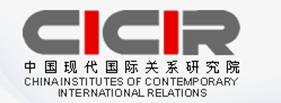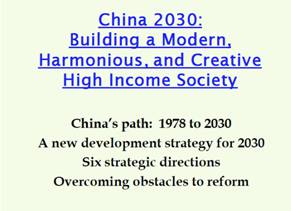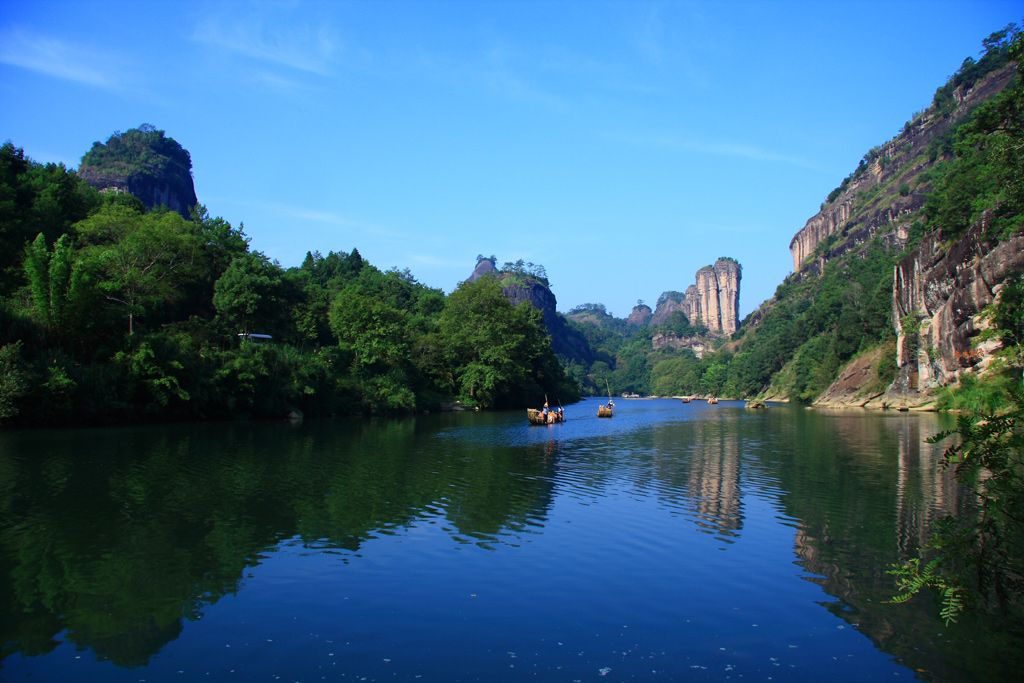
|
 |
|
| CHINESE ART |
|
|
| From the late 4th century BC China was equipped with philosophical and religious tradition that emphasizes living in harmony, named Taoism and derived from the Tao that originally means "way", "path" or "principle". The Tao is the source and essence of everything that exists.
Taoist propriety and ethics may vary depending on the particular school, but in general tends to emphasize wu wei (action through non-action), simplicity, spontaneity, harmony between the individual and the cosmos, and the Three Treasures: Compassion, Moderation, and Humility. Taoism has had profound influence on Chinese culture in course of the centuries, and clerics of institutionalised Taoism usually take care to note distinction between their ritual tradition and the customs and practices found in Chinese folk religion as these distinctions sometimes appear blurred. Chinese alchemy (especially neidan), Chinese astrology, Zen Buddhism, several martial arts, Traditional Chinese medicine, feng shui, and many styles of qigong have been intertwined with Taoism throughout history. Beyond China, Taoism also had influence on surrounding societies in Asia. After Laozi and Zhuangzi the literature of Taoism grew steadily and used to be compiled in form of a canon – the Daozang, which was at times published at the behest of the emperor. Throughout Chinese history, Taoism was several times nominated as state religion. After the 17th century, however, it fell much from favor. Like all other religious activity, Taoism was suppressed in the first decades of the People's Republic of China (and even persecuted during the Cultural Revolution), but continued to be practised in Taiwan. Today, it is one of five religions recognized in the PRC, and although it does not travel readily from its Asian roots, claims adherents in a number of societies. |
 (1).jpg) |
|
| Chinese Renaissance |
The Third Plenum is the third plenary session of a newly elected Central Committee of the Communist Party of China. It often refers to the plenary meeting of the CPC Central Committee held in Beijing from December 18 to December 22, 1978, which marked the beginning of China's "Reform and Opening Up" policy. |
 |
Since then, third plenums of the Committee have taken on the mission to boost economic growth and deepen the economic structure reforms. As a result, the meeting witnesses many critical decisions being made. In other words, the third plenum has become synonymous with "reform." The Communist Party of China has thus far held the meeting seven times with "deepening reform" as its ongoing theme.
In Jul y 2024, the Third Plenary Session of the 20th Central Committee of the Communist Party of China was held. At the session, the Central Committee fully affirmed the work of the Political Bureau since the second plenary session of the 20th Central Committee. It was unanimously agreed that in the face of a grave and complex international environment and the arduous tasks of advancing reform and development and ensuring stability at home, the Political Bureau has secured progress in the following respects: -- earnestly implementing the guiding principles from the 20th National Party Congress and the first and second plenary sessions of the 20th Central Committee; |
During a lecture on China in October 2012, it was discussed that China is working on a return of former glory of the past as a superpower, a Chinese Renaissance. In former times, there were eras of thinkers (Confucius, Lao Tse), artists, the writing, yin and yang, cuisine, medicine, the Chinese wall, compass, gunpowder, paper, book printing, highest income per capita, largest seafarer, largest economy and best technology till the Industrial Revolution.
From 1839 (the Opium Wars) until about 1978 followed years of humiliation. The period from 1978 to date is characterized by China's return to the world stage and where achieving economic growth became more important than the importance of ideology. Beijing Consensus, an alternative economic development model to the Washington Consensus (an orientation towards neoliberal policies), focuses on economics and politics, not democracy with the aim return of former glory of the past but with a new look.
|

|
And now in 2015, with a decade of unprecedented economic growth, China is now entering a new era of economic, social and political development, impacted by its new position as the world’s second largest economy, with a booming middle class population but crippling environmental concerns. China is now focusing more on the quality of their growth rather than growth ‘at any cost’. Out of the plethora of new Plans, Strategies and Visions created by Chinese government agencies, the “Vision and Actions on Jointly Building the Silk Road Economic Belt and the 21st Century Maritime Silk Road” or more simply known as the “ONE BELT, ONE ROAD INITIATIVE” epitomises China’s new approach to foreign policy. The Initiative is an extension of China’s ‘go out’ and ‘go west’ policies and represents a move by the Government to be more targeted, strategic and focused in its future development. DavidThomas (Think Global) wrote: The Initiative aims to consolidate and upgrade existing infrastructure and build new transport routes to improve cross-border trade. It also includes efforts to promote a greater financial integration of the Renminbi with foreign countries and create a “Digital Silk Road” of international communication and information distribution. The “Silk Road Economic Belt” connects China via land with Central Asia, Russia, Europe and Southeast Asia. The “21st Century Maritime Silk Road” makes a link from the Indian Ocean, through the South China Sea to the South Pacific Ocean (see map). Geographically positioned in the middle of both the Belt and the Road, China has emerged as the facilitator in developing a connection between Europe and Asia. All roads lead to China Similar to the Roman Empire’s network of roads, rail and ports, The Initiative has given major priority to infrastructure. Plans are already in place to build railway networks, port facilities, airports, highways and electronic communication networks to guarantee smoother and more efficient transportation of goods and people, from Southeast Asia to Western Europe. The Asian Development Bank, managed by Japan and independent of The Initiative, has estimated that in order to support the expected volume of international trade produced from The Initiative, Asian countries must invest US$8 trillion to bring their facilities up to world standards. China has already conducted feasibility studies on four international high-speed railways – the Europe-Asia, Central Asia, Pan-Asia and China-Russia-America-Canada high-speed rail lines. Poland also recently signed a MOU with China which includes railway projects linking China’s city of Chengdu with the Polish city of Lodz, as well as linking Suzhou, in Jiangsu Province, with Warsaw. Supporting these infrastructure developments, China has opened up discussions to open new ‘free trade zones’ and ‘trade co-operation zones’. Currently, there are 77 economic and trade co-operation zones in 23 countries along the Belt and Road including within Russia, Hungary, Romania, Laos, Thailand and Indonesia. Financial support To support these major plans, China has been actively promoting the establishment of the Asian Infrastructure Investment Bank (AIIB), The BRICS New Development Bank and the Silk Road Fund. The US$100 billion AIIB attracted global controversy in early 2015 when the US publically criticised the Bank and typical allies like the UK and Australia who ‘broke ranks’ and joined the Bank. The creation of the AIIB represents one of the first steps of The Initiative. 57 nations, including Australia, Brazil, Germany and Russia have signed up. Still in its development phase, it is maybe too early to assess whether or not the Bank will operate effectively. What has been noted is that it represents a shift in Chinese diplomacy from typically acting independently and unilaterally to being more collaborative and regionally-focused. Domestic investment Besides forming the basis of China’s new foreign policy, Xi Jinping has also made The Initiative a key domestic economic strategy. Under the plan, China plans to develop various key regions in China – the inland regions, north-western and north-eastern regions, south-western region and coastal regions. In the north-western region, the Initiative has appointed Xinjiang province as a key area on the Belt as it shares its borders with Mongolia, Russia, Kazakhstan, Kyrgyzstan, Tajikistan, Afghanistan and Pakistan. Rail links are also expected to improve transportation between Heilongjiang province and neighbouring Russia. In the south-west, Guangxi and Yunnan provinces will play key roles in opening up the Greater Mekong sub-region. Ports in China’s coastal cities such as Ningbo-Zhoushan, Fuzhou, Xiamen and Shenzhen will be further developed to facilitate increasing volumes of maritime trade. Most importantly, the Initiative has made specific plans to establish Chongqing as the key to opening up and growing China’s western region (‘go west’ policy). This will be supported by developing Chengdu, Xian and Zhengzhou to open up the inland areas and act as a key region for railway transportation to Europe. The cities themselves are also making their own plans for the Initiative – more than two-thirds of the 28 mainland provinces have already done so. For example, Chongqing has published their own plans to implement The Initiative and has pledged to invest RMB1.2 trillion in infrastructure before 2020.These policies reflect China’s seriousness in continuing and further enhancing its ‘go west’ policy, a cornerstone of the 12th Five Year Plan. By improving connectivity between China’s poorer western regions with the wealthy eastern coast, The Initiative hopes to spur more regionally focused growth, contributing to China’s overall aim of sustainable and balanced economic growth. International diplomacy or domestic interests? Despite Beijing’s attempts to stress the ‘win-win’ potential of The Initiative, many countries are deeply concerned about its geopolitical impacts. Key regional players such as Japan, Russia and India are particularly anxious about the increasing levels of Chinese influence in their respective regions. In addition, The Initiative runs the risk of being too ‘China-centric’ with the other participating nations only reaping marginal benefits. It is therefore imperative that China recognises these concerns, remains transparent in their plans and communicates regularly with all parties. Motivations aside, The Initiative and the development of its supplementary Asian Infrastructure Investment Bank demonstrate an enormous potential to enhance economic growth and sustainable development not only throughout Asia but within China itself. Another major indication of China’s influence, both regionally and globally, as we advance deeper into the Asian Century. |
|
The Chinese prime minister stood up for the strikers, traveled to the province of Guangdong and wanted the workers 'take care of, protected and respected'. From both sides, no violence was used. And there were rise in wages till 70% (from 120 to 200 euro a month). This is exactly what should happen economically and socially: more advantage and prosperity for the Chinese in stead of only cheap hands for a western sale market. Furthermore, it occurred that it mainly concerned foreign suppliers - first especially Japanese business. The big strike in the North, Toyota and in the South Honda. Later, it was added by the big supplier Apple. A strike against Japanese may reckon on symphaty, reaching to Chinese circles of government. And concerning Apple: since years the company is flirting with its genius concept of added value: design and marketing id for Apple, the rest is for somebody else. Or translated in money: every iPhone earns usd 70 and usd 1,50 for the Chinese supplier with its thens of thousands workers. That shows not a lot of respect. But Chinese authorities can also act in another way: in 2008 big series of strikes bleeded to death slowly. In 2002 cole- and steelstrikes were stopped with sword in hand. Present strikers however, are of age. They are better educated, make more easy contact with each other by mobile-phones and they smelled progression. But all of this does not take care that Chinese rulers will step aside. |
Europe will only be able to deal effectively with rising powers like China if it understands China's approach to a world undergoing historical changes. It passed that China welcomed the new capital and liquidity rules contained in Basel III and would start implementing them from early 2012.
In Geopolitics on Chinese Terms the authors show how China is altering its foreign policy approach in an increasingly multi-polar world:
|
| A GLOBAL CHINA POLICY (ECFR) |
A GLOBAL CHINA POLICY (ECFR)
China now affects every global issue from trade and the economy to climate change and nuclear proliferation, as well as every region from Africa to the Middle East. Europe therefore needs to reframe its China policy in global terms. Instead of thinking of their relationship with China in bilateral terms, EU member states need to take into account China’s impact across all of the issues in European foreign policy and in relations with all other countries and regions. Europe needs to co-ordinate its own policy more effectively, preferably at EU level, and to cooperate with other countries to increase its limited leverage over China. In short, Europe needs a global China policy. At the same time, many of the key decisions in China’s foreign policy are now taken by domestic actors who are largely unknown to foreigners. Europe needs to identify and engage with these actors. In the past, EU member states have struggled to co-ordinate even their own policy toward China, let alone co-operate with other countries. But although China now feels more powerful than ever, especially after the global economic crisis, greater tension between China and both its neighbours and the US offers new opportunities for Europe to form new coalitions and to increase its leverage over China. Europe should also reach out to the new actors in the Chinese system with whom it may share interests. To make this global China policy work, however, Europe will need to focus on a limited number of priorities. In particular, the EU should focus its relationship with China on five issues: trade and investment policy; industry and technology; climate change; nuclear proliferation and Iran; and human rights. The World Bank notified that China should complete its transition to a market economy -- through enterprise, land, labor, and financial sector reforms -- strengthen its private sector, open its markets to greater competition and innovation, and ensure equality of opportunity to help achieve its goal of a new structure for economic growth. |
These are some of the key findings of a joint research report by a team from the World Bank and the Development Research Center of China’s State Council, which lays out the case for a new development strategy for China to rebalance the role of government and market, private sector and society, to reach the goal of a high income country by 2030.
The report, “China 2030: Building a Modern, Harmonious, and Creative High-Income Society”, recommends steps to deal with the risks facing China over the next 20 years, including the risk of a hard landing in the short term, as well as challenges posed by an ageing and shrinking workforce, rising inequality, environmental stresses, and external imbalances and lays out six strategic directions for China’s future. |
 |
Already on July 16, 2001, a twenty year strategic Treaty of Good-Neighborliness and Friendly Cooperation Between the People's Republic of China and the Russian Federation (FCT) was signed by the leaders of the two international powers. The treaty outlines the broad strokes which are to serve as a basis for peaceful relations, economic cooperation, as well as diplomatic and geopolitical reliance. Controversially, Article 9 of the treaty can be seen as an implicit defense pact, and other articles point at increasing military cooperation, including the sharing of "military know-how", namely, Chinese access to Russian military technology. The treaty also encompasses a mutual, cooperative approach to environmental technology regulations and energy conservation; and toward international finance and trade. The document affirms Russia's stand on Taiwan as "an inalienable part of China", and highlights the commitment to ensure the "national unity and territorial integrity" in the two countries. |
| NATURE |
 |
The Wuyi Mountains are a mountain range located in the prefecture of Nanping, in the northern border of Fujian province with Jiangxi province. The mountains cover an area of 60 km². In 1999, Mount Wuyi entered UNESCO's list of World Heritage Sites, both natural and cultural. It is the most outstanding biodiversity conservation zone of Southeast China. Numerous types of tea are produced around Mount Wuyi; it is the origin of the real Da Hong Pao tea and Lapsang souchong, further described in Wuyi tea. |